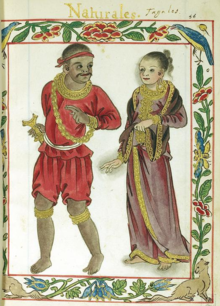Maharlika
| Part of a series on the |
| Pre-colonial history of the Philippines |
|---|
 |
| See also: History of the Philippines |
The maharlika (
Overview

The maharlika were a martial class of freemen.
Unlike the timawa, however, the maharlika were more militarily-oriented than the timawa nobility of the Visayas.[4] While the maharlika could change allegiances by marriage or by emigration like the timawa, they were required to host a feast in honor of their current datu and paid a sum ranging from six to eighteen pieces of gold before they could be freed from their obligations. In contrast, the timawa were free to change allegiances at any time,[2] as exemplified by the action of Rajah Humabon upon the arrival of Ferdinand Magellan.[citation needed]
The earliest appearance of the term is manlica mentioned in the
After the Spanish conquest, the Spanish translated the name maharlika as Hidalgos (or libres).[7]
Etymology
The term maharlika is a
In some Indo-Malayan languages, as well as the languages of the Muslim areas of the Philippines, the cognates mardika, merdeka, merdeheka, and maradika mean "freedom" or "freemen" (as opposed to servitude).[9] The Malay term mandulika, also meant "governor".[5]
The
The name of the
Modern usage
Usage as propaganda during the Marcos regime
During the "New Society Movement" (
Marcos's use of the word started during
A later variant of the hoax linked with Marcos historical distortionism falsely claimed that the whole Philippine archipelago had once been a single "Maharlika Kingdom," and that Marcos' alleged personal wealth came about because the so-called royal family of this kingdom had hired Marcos as their lawyer in the days after World War II, paying him "192 thousand tons of gold" for his legal services.[14][15]
Usage as a new name for the Philippines
Senator Eddie Ilarde was the first to propose to rename the Philippines into "Maharlika" in 1978, citing the need to honor the country's ancient heritage before the Spanish and Americans occupied the country. Ferdinand Marcos was in favor of changing the name of the Philippines into "Maharlika", thinking it meant "nobility", as a symbol of nationalism. In 2019, President Rodrigo Duterte reiterated the idea, thinking that it means "more of a concept of serenity and peace".[16]
Usage in popular culture
The modern use of maharlika persists in original Philippine music (OPM), notably in the lyrics of "Ako ay Pilipino", a song commissioned by Ferdinand Marcos' First Lady, Imelda Marcos.
The word maharlika is used by the semi-professional basketball league
See also
- Arnis/Eskrima/Kali
- Eskrima in popular culture
- Bagani
- Bolo knife
- Conspiracy of the Maharlikas
- Filipino martial arts
- Juramentado
- Kinamutay
- Knight
- Kshatriya
- Maradeka
- Merdeka
- Samurai
- Sikaran
- Suntukan
- Timawa
References
- ^ Jamaique, Mona (1971). Hymes, Dell H. (ed.). Pidginization and Creolization of Languages. CIP Archive. p. 240.
- ^ a b c d e Morrow, Paul (January 16, 2009). "Maharlika and the ancient class system". Pilipino Express. Archived from the original on January 19, 2009. Retrieved July 18, 2012.
- ISBN 9789715425681.
- ^ ISBN 9789715501354.
- ^ ISBN 9789004301542.
Las maneras de ditados que entre ellos ay es sultan que quiere dezir rrey rraxa que quiere dezir prinçipe panguilan que quiere dezir señor de titulo urancaya que quiere dezir hombre prinçipal mantiri que quiere dezir capitan uranbaye que quiere dezir hombre bueno manlica que quiere dezir libre lascar que quiere dezir esclauo gente de guerra quiere dezir uran barca lai.
- ISBN 9789715503471.
- ^ ISBN 978-971-10-0524-5.
- ^ Morrow, Paul (January 16, 2009). "Maharlika and the ancient class system". Pilipino Express. Retrieved February 15, 2019.
- ^ ISBN 9783110134179.
- JSTOR 44158475.
- ISBN 9789814345255.
- ^ Quimpo, Nathan Gilbert. Filipino nationalism is a contradiction in terms, Colonial Name, Colonial Mentality and Ethnocentrism, Part One of Four, "Kasama" Vol. 17 No. 3 / July–August–September 2003 / Solidarity Philippines Australia Network, cpcabrisbance.org
- ^ Hizon, Ernie M. (March 6, 1987). "Nothing noble about 'Maharlika'". Manila Standard. Standard Publications, Inc. p. 14. Retrieved January 19, 2021.
- ^ "FALSE: Filipino 'royal family' ruled over pre-colonial 'Maharlika kingdom'". Retrieved January 7, 2021.
- ^ INQUIRER.net (December 22, 2015). "IN THE KNOW: December 22, 2015". Philippine Daily Inquirer. Retrieved January 7, 2021.
- ^ FLORES, MIKHAIL (February 13, 2019). "Duterte wants Philippines renamed 'Maharlika'".
External links
 Media related to Maharlika at Wikimedia Commons
Media related to Maharlika at Wikimedia Commons
